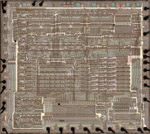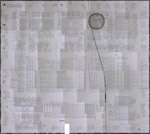Atari 10444D 'TIA' Die Shots
The Atari 10444D 'TIA' (Television Interface Adapter) chip is the heart of the Atari 2600 VCS game system. It controls the 6502, providing the clock signal and waking the CPU from its requested periods of sleep. It generates the TV video signal with luminance on several digital output pads and with color controlled by a variable phase shifter block. It also generates sound from a built-in waveform generator.
Working with a single TIA chip, the Visual6502 project exposed the microprocessor die and imaged the surface and substrate on May 21, 2010. The die suffered a crack in this process, but the crack did not affect subsequent conversion of the bitmaps images into vector polygons. Vectorization began on May 26, 2010 and after 133 man-hours of work, was completed on July 7, 2010. After bringing up the chip in simulation, two vectorization errors were detected and corrected by July 23, 2010.
Below are the aligned surface and substrate images used to create the vector model. They are 4500 x 4031 pixels. The original stitched images are roughly twice the size in each dimension. These were stitched from many sub-images shot on a Nikon Optiphot 200 with 10x objective and roughly 20x additional magnification going to the camera.
The sound generators are on the left edge in these images, ending in two 4-bit DACs along the top edge. These are the 3rd and 4th pads from the left edge, where the DACs are immediately to the left and right of the pads, and the left most DAC looks like the 'signal bars' display on today's cell phones. The sprite engines are along the top, register section in the middle, and ROM instruction decoder on the bottom.
Our vector model consists of 28751 polygons. There are 6193 transistors, 1657 of which are NMOS pullup gates that function as leaky variable resistors in the circuit.
By coupling a simulation of this chip to our simulation of the MOS 6502 and an emulated ROM and 6532 we're able to generate frames of video from classic Atari 2600 video games.
See our links page for more information about the Atari system, and read about the TIA on Wikipedia.
If you find our images or work useful please consider a donation to further our work.

